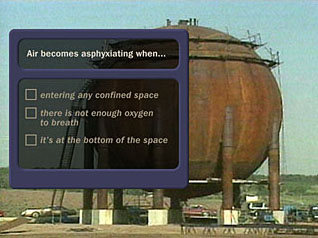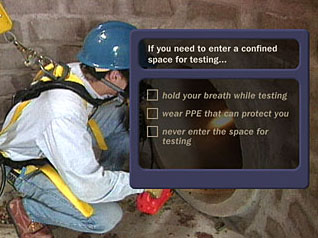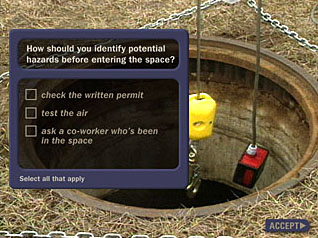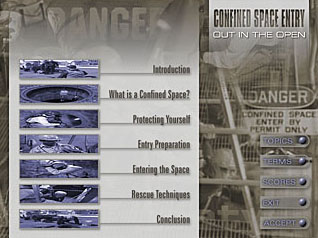Confined Space Entry: Out In The Open
- Product ID
- clcsempg
- Training Time ?
- 58 to 116 minutes
- Language(s)
- English,Spanish,French (Canadian),Dutch (Flemish)
- Video Format
- Standard Definition
- Required Plugins
- MasteryNet Player
- Lesson Interactions
- 14
- Quiz Questions
- 24



Get OSHA-Compliant Confined Space Training
Confined Space Training uses full-motion video to teach the hazards associated with confined spaces. This course complies with OSHA's training requirement for all employees who work in confined spaces. Workers will learn proper procedures for entrants and attendants as well as proper rescue procedures. Confined Space Training uses high quality video footage to help your workers identify confinement hazards, convey proper preparation procedures, and teach entrant and attendant duties. This confined space training course qualifies for continuing education units and is a key component in your online osha training program.
OSHA REGULATION: OSHA 29 CFR 1910.146
![]() This course is in the Advantage™ format, to read about Advantage™ features click here.
This course is in the Advantage™ format, to read about Advantage™ features click here.

- Rich multimedia presentation with interactions and quiz
- Print certificate and wallet card
- You have 30 days to complete the course
Confined Space Training is for all employees who work as entrants in a confined space, or attendants of a confined space.
-
What is A Confined Space
- Defining a confined space
- Asphyxiating atmospheres
- Toxic atmospheres
- Flammable or explosive atmospheres
- Mechanical hazards
- Physical hazards
- Engulfment
-
Hazard Protection
- Precautions
- The entry permit
-
Entry Preparation
- Isolating the space
- Explosive atmospheres
- Cleaning residue
- Air testing
- Atmospheric hazards
- Personal protective equipment
-
Entering The Space
- The attendant
- The entrant
-
Rescue Techniques
- Understanding the rescue process
- Non-entry rescue
- Entry by others
- Entry by trained company employees
-
Recognize confined space hazards.
- Identify types of hazards in confined spaces.
- Choose reasons why oxygen could be depleted.
- Recognize flammable and explosive atmospheres as confined space hazards.
- Choose examples of engulfment hazards.
- Identify an example of a mechanical hazard in a confined space.
- Identify falls and excessive noise as confined space hazards.
- Define a confined space.
-
Use proper controls for confined space entries.
- List steps to protect yourself from confined space hazards.
- Describe the entry permit.
- Select information included on a confined space entry permit.
- Explain what to do if a permit expires before work is complete.
-
Properly prepare for confined space entry.
- State the first step in entry preparation.
- Choose examples of proper entry preparation.
- Agree to check the permit to help identify potential hazards.
- Explain how to isolate a confined space from chemical process hazards.
- Agree to clean all tanks or vessels that contain hazardous residues before working in a confined space.
- List types of personal protective equipment you may use in a confined space.
-
Use proper testing techniques for confined spaces.
- List necessary steps of air testing.
- Choose the correct order for testing gases.
- Recall the need to wear appropriate personal protective equipment if testing must be done in a confined space.
-
Use proper confined space entry procedures.
- Differentiate between the entrant and the attendant.
- Select the area where the attendant should be stationed.
- Identify attendant responsibilities.
- Identify entrant responsibilities.
-
Follow proper confined space rescue techniques.
- Recall that 60% of confined space deaths involve people trying to rescue other injured people.
- List the three types of confined space rescues.
- Agree that if a non-entry rescue is not possible, trained people must perform the rescue.
- List the requirements of an on-site rescue team.
© Mastery Technologies, Inc.




